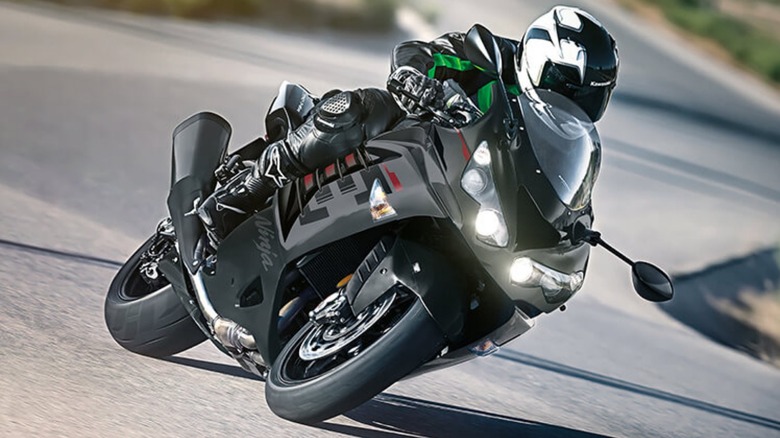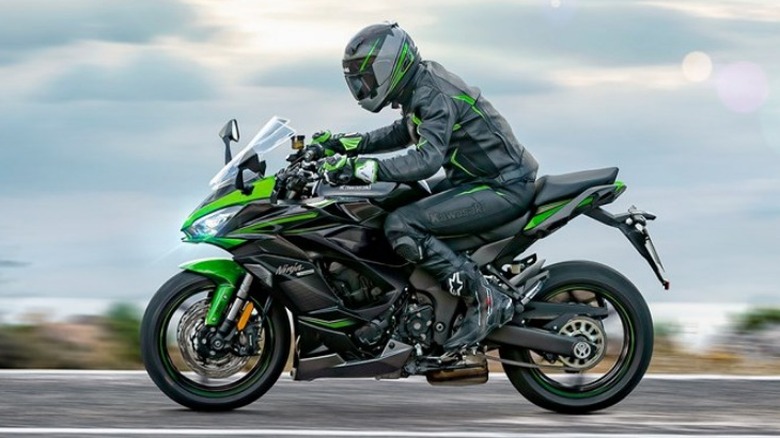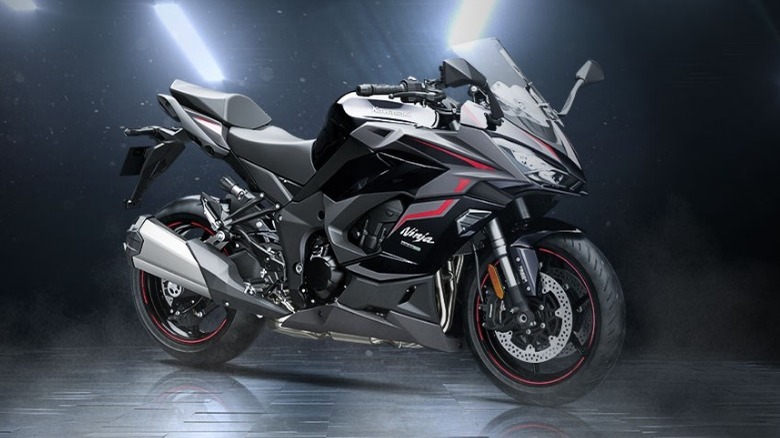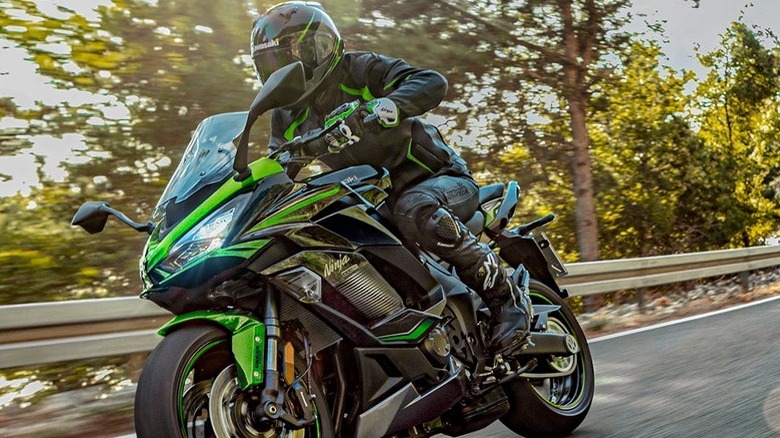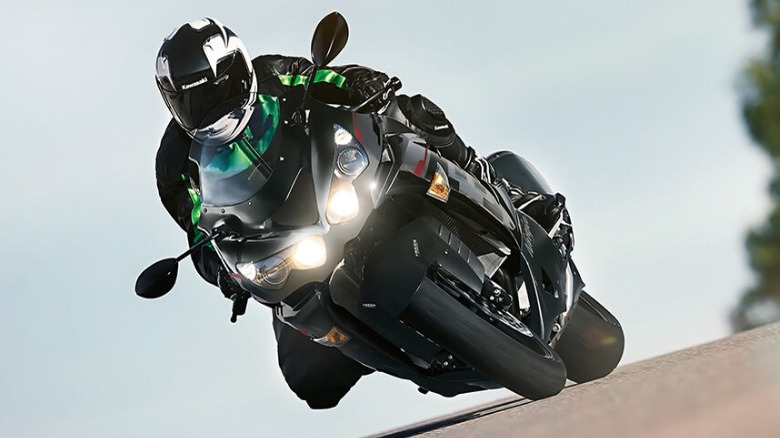Kawasaki Ninja 1000 SX Vs. Ninja ZX-14R: What Are The Differences?
Kawasaki makes a lot of different kinds of motorcycles, but you'll find that the company produces a particularly wide range of sport bikes. There are 13 different models currently available in the Ninja line alone, including the electronic E1 model, the Ninja 7 hybrid model, and several variations of Sport, Supersport, and Hypersport. It's easy to see how this large catalog can sometimes leave prospective buyers scratching their heads when comparing two similar Ninjas, such as the Ninja 1000 SX and the Ninja ZX-14R.
These are both considered to be powerful, high-end street bikes. Each of them is the top-of-the-line model for their respective sub-categories, and Kawasaki even advertises both of them in a similar gray and red color scheme. That doesn't mean that these bikes are the same, however, and those who are thinking about picking one of these up for their daily ride will definitely want to know what sets them apart. You can get a pretty good idea of what separates these two powerful motorcycles by taking a look at the categories they reside in, as well as the physical differences in their engines, size metrics, cornering capabilities, and features. Here are a few of the biggest differences.
Comparing Sport vs. Supersport
The first step in understanding the differences between the 1000SX and the ZX-14R is understanding Kawasaki's model designation terms. All Ninjas are sport bikes, but Kawasaki has split this designation into three subcategories to further distinguish bikes that have different tuning, designs, supplementary components, and feature sets.
In ascending order; the Sport, Supersport, and Hypersport sub-categories offer increasingly powerful performance-focused upgrades. The 1000 SX is the top-tier bike in the manufacturer's standard Ninja Sport line. As sport bikes, these are designed with speed, torque, and cornering at the foreground, but the standard Ninjas also tend to have several comfort and convenience-focused features, such as a wide seat and smartphone connectivity, which make them ideal commuter vehicles that are also great for weekends at the track or taking a ride out on a winding canyon road.
The ZX-14R, on the other hand, is part of the Supersport sub-category. These bikes tend to offer higher performance metrics, even when you compare them to standard Sport Ninja models with similar engine sizes like the Ninja 650 and ZX-6R. They tend to have higher horsepower and torque than their Sport counterparts, and may even offer other features like upgraded wheels, breaks, and suspension.
The ZX-14R has a bigger engine
Now, let's move on to the actual specs: The Ninja 1000 SX is powered by a 1,043cc, in-line four-stroke, DOHC, 16-valve, liquid-cooled engine. It has a 77mm bore, a 56mm stroke, and an 11.8:1 compression ratio. This is the largest and most powerful engine in the standard Ninja line, giving the bike a maximum of 140.7 horsepower at 10,000 rpm and a maximum torque of 111 lb-ft at 7,300 rpm. That's certainly nothing to sneeze at, and the 1000 SX should have more than enough bike for the average rider. In fact, this engine is actually a tiny bit larger than the 998cc one that powers the ZX-10R.
That said, the Ninja ZX-14R offers a significant boost in both engine size and performance for those who want it. This bike has a 1,441cc, in-line four-stroke, DOHC 16-valve, liquid-cooled engine. It has an 84mm bore, a 65mm stroke, and a 12.3:1 compression ratio. This gives the bike 208 horsepower and 113 lb-ft of torque. Compare that to the specs above and you'll see that the two bikes have a fairly comparable amount of get-up-and-go, but the ZX-14R is going to offer significantly more raw power, particularly at higher speeds.
The 1000 SX is smaller and more angular
Another aspect to consider is the overall body design. The 1000 SX and ZX-14R are both sport bikes, but even a casual observer can tell that they have very different design philosophies. The 1000 SX is a slightly smaller bike that has a more angular structure. It's 82.7" long, 32.5" wide, has a 32.3" seat height, and weighs 513.8 lbs. (U.S. model is 516 lbs.).
Everything from its fairings to its rearview mirrors and seat cushions is constructed from sharp angles that are designed to give the bike a more jagged and aggressive appearance. "Edgy lines provide modern styling and optimized wind protection," says Kawasaki. "A single-sided muffler further enhances the inherent Ninja styling, reflecting the dynamic experience you get with every ride."
The ZX-14R is longer, narrower, and has much more rounded lines. It's 85.4" long, 30.3" wide, has a 31.5" seat height, and weighs 593.1 lbs — making it a full 80 lbs heavier. Every design element, from the fairings to the exhaust, is more elegantly curved. This makes the ZX-14R seem more refined in some ways, but in other aspects — such as the aerodynamic fins just in front of the knee cutouts — still manage to stand out and give the bike a striking appearance.
The more interesting part of the ZX-14R's construction is just beneath the surface, however. It has Kawasaki's monocoque frame which "uses the engine as a fixed member so that chassis rigidity is formed not only by the frame, but the combination of the frame and engine together."
The ZX-14R has more aggressive cornering
Any time you're talking about a sport bike, it's also worth taking a look at how they handle sharp turns. These bikes tend to be more adept at maneuvering winding roads and racetracks than they are spending long hours on flat stretches of highway. The 1000 SX has a 24-degree rake and a 3.9" trail. That's already a pretty aggressive angle, but the ZX-14R is even more severe. It has a 23-degree rake and a 3.7" trail, making it ever-so-slightly more upright than its smaller sibling.
Then we need to take a look at the suspension. The 1000 SX has a 41mm inverted front fork which has step-less compression and rebound damping, as well as spring preload adjustability. In the rear, it has a horizontal back-link rear suspension. Kawasaki states that this offers "remote rebound and preload adjustability for tandem riding, luggage or rider preference." The ZX-14R has a 43mm inverted cartridge fork in the front and a Bottom-link Uni-Trak and gas-charged shock in the back. Both of these have an adjustable preload, as well as compression and rebound dampening adjustments.
Both of these bikes have Kawasaki Traction Control, which allows you to choose from several different modes that are each designed to give the bikes better traction for different road conditions. The 1000 SX is the only one to come with the Kawasaki Cornering Management Function, which monitors the parameters of the corner before modulating the bike's brake and engine force in order to make the turn smoother.
The 1000 SX has more comfort and convenience features
We've already looked at the traction and cornering technology that Kawasaki has embedded in these beauties, but each of these bikes has several other features that riders can take advantage of as well. This is one of the few areas where the 1000 SX truly excels over the ZX-14R. Both bikes have an economical riding indicator, Kawasaki Traction Control, multiple power modes, and anti-lock brakes. There are only two technologies that Kawasaki advertises the ZX-14R having that the 1000 SX doesn't: Dual throttle valves to regulate intake airflow during acceleration with the built in ECU, and the aforementioned monocoque frame.
The SX has a few more convenience-focused technologies. It has an electronic cruise controls, electronic throttle valves, and the cornering management function. Then it has the Kawasaki Quick Shifter, which allows riders to upshift without needing to release the throttle, smartphone connectivity for vehicle information monitoring riding logs, and GPS. IMU enhanced chassis orientation awareness monitors the inertia, calculates the yaw rate, and helps to orient the chassis.
Finally, its KIBS intelligent antilock brake system links the ABS to the ECU, which allows it to monitor speed, throttle position, clutch actuation, gear position, and caliper hydraulic pressure in order to determine the ideal break hydraulic pressure.
The difference in price
One of the most important factors that anyone considering purchasing one of these bikes needs to consider is how much they're going to have to pay to get their hands on one. Neither of these motorcycles MSRPs come close to the exorbitant price tags that Kawasaki charges for it's H2 Hypersport models, but they're not exactly cheap either.
The 2024 Ninja 1000 SX ABS has a starting MSRP of $13,699, making it the most expensive standard Ninja in Kawasaki's lineup, but still fairly reasonable in comparison. Meanwhile, there are two versions of the ZX-14R that each have their own price tag: The 2023 Ninja ZX-14R ABS MSRPs at $16,599, then there is the Ninja ZX-14R 40th Anniversary Edition ABS, which goes for $17,249.
This gap in price is significant, but it seems appropriate given the difference in engine size and performance. ZX bikes cost more than their standard Ninja counterparts across the board, so it makes sense that this would be no different. Those seeking a daily ride with all the bells and whistles still might find that they're better off saving some money with the smaller 1000 SX, however.
